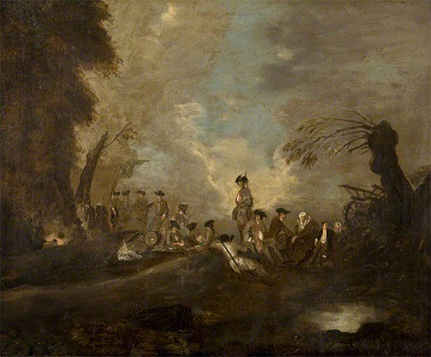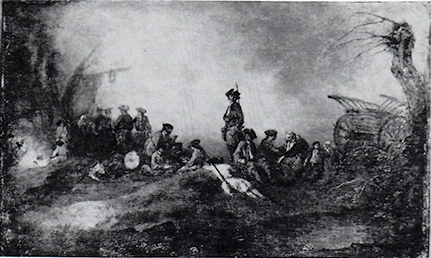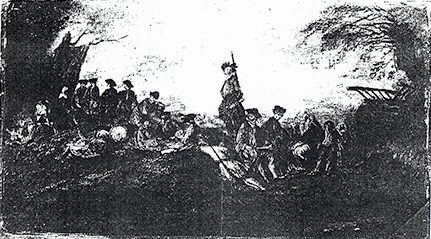
- Home Page
- Accepted
Paintings & Copies - Doubtful
Attributions - Doubtful Textual References
- Alternative
Titles - Collectors &
Museums - Bibliography
- Search Abecedario
- Watteau &
His Circle
Détachement faisant alte (copy 1)
Entered July 2020

Glasgow, Kelvingrove Art Gallery and Museum, inv. 392.
Oil on canvas
64.2 x 80.3 cm
ALTERNATIVE TITLES
Detachment Resting
The Encampment
Halte d’armée
Sosta di soldati
PROVENANCE
Glasgow, collection of William Euing (1788-1874; insurance underwriter and broker); bequeathed to the museum in 1874.
EXHIBITIONS
Glasgow, Kelvingrove, French and British Artists (1902), cat. 44 (by Watteau, The Encampment—Halte d’armée).
SELECT BIBLIOGRAPHY
Zimmermann, Watteau (1912), pl. 127.
London, Burlington Fine Arts Club, French Art (1913), under cat. 5.
Valotaire, «La Recrue» (1919), 101-02.
Dacier, Vuaflart, and Hérold, Jean de Jullienne et les graveurs (1921-29), under cat. 179.
Réau, “Watteau” (1928), under cat. 39.
Adhémar, Watteau (1950), under cat. 70
Macchia and Montagni, L’opera completa di Watteau (1968), under cat. 55.
Ferré, Watteau (1972), cat. B 4.
REMARKS
A century ago the Glasgow museum believed its painting was by Watteau, but subsequent critics have been less optimistic. None have characterized it as anything but a copy.
Détachement faisant alte (copy 2)
Entered July 2020; revised April 2021

Whereabouts unknown
Oil on panel, transferred to canvas
23 x 37 cm
ALTERNATIVE TITLES
Camp Followers
Halte d‘Armée
PROVENANCE
Paris, c. 1771, where it was transferred from a wooden panel to canvas by Jean Louis Hacquin, as discussed below.
Paris, collection of baron Louis-Auguste de Schwiter (1805-1889; painter). His sale, Paris, May 3, 1886, lot 48: “WATTEAU (ANTOINE) . . . Détachement faisant halte. On lit dans le catalogue du musée du Louvre, par Fred. Villot, École Française, édition de 1855, page 414: «Pour se procurer de l’argent nécessaire il s’adresse à un peintre de son pays nommé Sponde [sic], que lui fit acheter au prix de soixantes livres ce premier tableau, gravé depuis par Cochin père; le marchand lui en commande le pendant que Watteau lui adresse de Valenciennes; celui-ci représentant une Halte d’armée, exécutée d’après nature, fut payé deux cents livres, et a été gravé aussi par Cochin.» On lit sur la gravure les vers suivants . . . Toile. Haut., 23 cent.; Larg., 37 cent.”
Dalskirth (Dumfries), Scotland, collection of William Allen Coats (1853-1926; thread manufacturer). His sale, London, Christies, June 10, 1927, lot 142: “A. WATTEAU . . . DÉTACHEMENT FAISANT HALTE / 8 ½ in. by 14 ½ in. A framed print by C. Cochin is sold with the picture.” Bought by “Rothschild” according to annotated copies of the sale catalogue in the Frick Art Reference Library, New York, and the National Arts Library, Victoria and Albert Museum, London.
Paris, with Georges Seligmann.
Sackerville collection.
EXHIBITIONS
London, Burlington Society, French Art (1913), cat. 5 (as by Watteau, Halte d’ Armée, lent by W. A. Coats).
SELECT BIBLIOGRAPHY
Goncourt, Catalogue, 360.
Staley, “Eighteenth Century Art” (1902), 420.
Josz, Watteau (1903), 102 n. 1.
Coats, Catalogue (1904), cat. CXI.
Dacier, Vuaflart, and Hérold, Jean de Jullienne et les graveurs (1921-29), under cat. 179.
Réau, “Watteau” (1928), under cat. 39.
Adhémar, Watteau (1950), under cat. 70.
Mathey, Watteau, peintures réapparues (1959), cat. 116.
Macchia and Montagni, L’opera completa di Watteau (1968), under cat. 55.
REMARKS
Although he does not explicitly state it, the picture that Mathey reproduces and that we show here seems to be the painting formerly in the Schwiter and Coats collections. On the basis of the photograph, Mathey thought it was Watteau’s original version but Adhémar had reservations.
According to Josz, the painting had a notice pasted on its back: “Ce tableau qui étoit peint sur bois a été enlevé et remis sur toile par Hacquin en 1771.” If nothing else, this label suggests that the painting was an early or mid-eighteenth century painting. In an excess of caution, this picture has been included among the copies after Détachement faisant halte, but it is possible that this is Watteau’s original painting.
The later whereabouts of this picture are unclear. Réau lists the painting as being with the Parisian dealer Germain Seligmann, Adhémar reported that it sold to Seligmann in 1920, while Macchia and Montagni say that he acquired it in 1927. These authors give no further information.
Adhémar, followed by Macchia and Montagni, list the painting as passing to the Sackerville collection, without further elucidation.
Détachement faisant alte (copy 3)
Entered July 2020; revised May 2021

Whereabouts unknown
Oil on panel
Measurements unknown
PROVENANCE
Paris, collection of baron Edgar Aimé Seillière (1835-1870; industrialist); by descent to his son, baron Ernest Seillière (1866-1955; journalist).
SELECT BIBLIOGRAPHY
Dacier, Vuaflart, and Hérold, Jean de Jullienne et les graveurs (1921-29), under cat. 179.
Réau, “Watteau” (1928), under cat. 39.
REMARKS
The painting was described by Dacier, Vuaflart, and Hérold as executed in the same sense as the engraving, and showing minor differences.
Détachement faisant alte (copy 4)
Entered July 2020

Fondation Septentrion, Marcq-en-Baroeul, France
Oil on panel
20.8 x 36.5 cm
REMARKS
My knowledge of this copy of Détachement faisant alte stems from a letter in the files of the Service de documentation, Département des peintures, Musée du Louvre. As per a letter from Pierre Rosenberg to the foundation, dated December 16, 1983, the sender thought that their version of the composition was superior to other known examples.
Détachement faisant alte (copy 5)
Entered July 2020

Whereabouts unknown
Medium unknown
Measurements unknown
PROVENANCE
Collection of a Russian emigré, Switzerland.
Private collection, canton of Grisons (or Graubünden), Switzerland.
Bern, Switzerland, collection of Hans Gfeller, c. 1979
REMARKS
My knowledge of this copy of Détachement faisant alte stems from a photograph in the files of the Service de documentation, Département des peintures, Musée du Louvre, Paris.